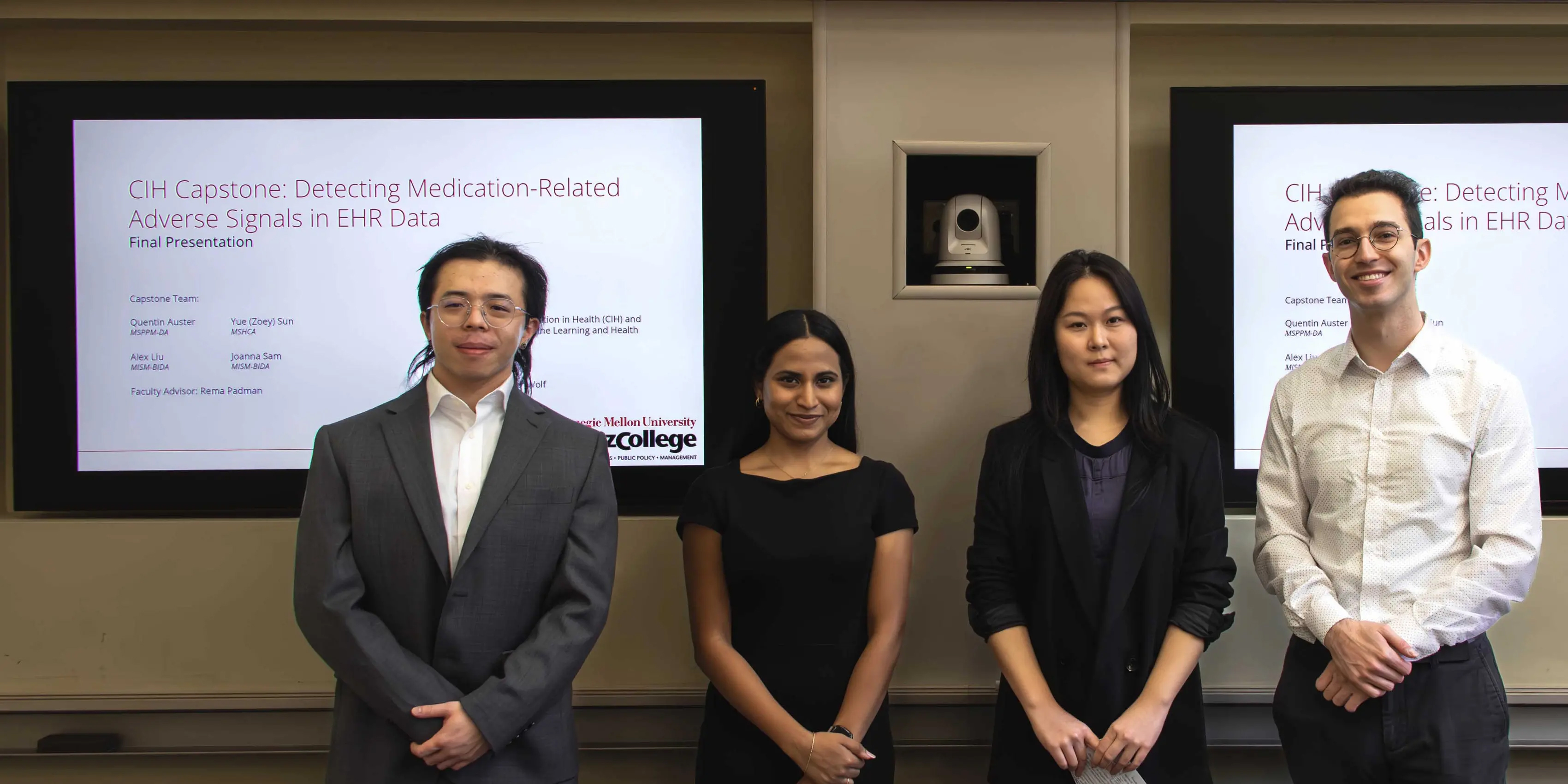Collaboration on AI-powered Patient Safety Research Flags Drug Side Effects
A recent capstone project by an interdisciplinary team of graduate students from Heinz College of Information Systems and Public Policy at Carnegie Mellon University and the University of Pittsburgh School of Medicine used artificial intelligence to examine health care data and look for patterns to detect potentially dangerous drug interactions.
Four CMU master’s degree students used AI and machine learning to review databases housed at the University of Pittsburgh to look for signals of adverse drug events, adverse drug reactions or medication errors in millions of records from more than 600,000 patients from across three years of routinely collected patient care data.
“We learned all these applied skills in class — data cleaning, data analysis — but then in real-world applications, you start to see all these obstacles that you have to know how to get around,” said Quentin Auster, a student in the Heinz College of Information Systems and Public Policy’s Master of Public Policy and Management: Data Analytics program. He led the capstone project team that also included Joanna Sam and (now-graduate) Alex Liu of the Master of Information Systems Program in Business Intelligence & Data Analytics; and Yue (Zoey) Sun, a student in the Master of Health Care Analytics & Information Technology Program.
The research team received access to the data through funding from the Pittsburgh Regional Autonomous Patient Safety (RAPS) initiative of the Jewish Healthcare Foundation that established Carnegie Mellon’s Initiative for Patient Safety Research (IPSR) in 2022 with a two-year $500,000 grant.
Detecting Adverse Events
The students mined association rules in the medication data using a method often applied to e-commerce data. Instead of suggesting similar products for customers to buy together, in this case they generated the rules from the data to guide the discovery of different medication combinations that may lead to adverse outcomes, said Rema Padman, Trustees Professor of Management Science and Healthcare Informatics in the Heinz College and faculty advisor of the capstone project. The team also collaborated with Ari Lightman, digital media and marketing professor in the Heinz College, and Alan Scheller-Wolf, Richard M. Cyert Professor of Operations Management in the Tepper School of Business, both faculty leads at IPSR who facilitated access to the data at the University of Pittsburgh.
Once these combinations are identified, researchers can determine those with the highest frequency within the hundreds of thousands of records in the dataset. Clinicians can use the information to verify the risk of an adverse reaction and identify alternative medications. Detecting and reviewing the importance of the anomalies in the data would be difficult without AI and machine learning, Padman said.
“These methods can really help to sift through the vast amounts of data, since every patient might be taking multiple medications, and with thousands of patients, there are many different combinations to examine,” she said. “We can apply these methods to extract some useful information.”
Uncovering Patterns Within The Data
The team from Carnegie Mellon collaborated with Richard D. Boyce, Associate Professor of Biomedical Informatics at the University of Pittsburgh, and his research team to obtain secure access to the data, including Pitt’s Medication Error Avoidance at Regional Scale (MEARs) database and the U.S. Food and Drug Administration’s Adverse Event Reporting System database (FAERS), and specialized domain knowledge about MEARs and medication-related errors.
The collaboration allowed for more resources to be dedicated toward eventually making an impact, Scheller-Wolf said.
“The dream is to solve these really big, complicated problems in society, like adverse medical events, but you’re not going to have one person solve it, or even one university,” he said. “We need a team, and collaborating across Oakland with Pitt has a huge advantage.”
The capstone team conducted research through an open-source approach in a highly secure virtual workbench using a combination of data science tools that included a user-friendly research web application for large-scale analytics developed by the Observational Health Data Sciences and Informatics (or OHDSI, “Odyssey”) collaborative. As the students progressed, they gained an understanding of patient journeys through visualization and analysis.
The team demonstrated their approach by narrowing their focus to patients taking colchicine, typically used to treat gout but increasingly prescribed to prevent coronary artery disease. Then, they looked for the antibiotic clarithromycin and medications like it that influence how the body breaks down colchicine.

“If you are a doctor practicing every day, you should know this already, so you shouldn’t have prescribed this combination together,” Sun said. “We wouldn’t expect to see a lot of instances in the EHR (electronic health record) system, which added to the difficulty for us to research and study trying to find this combination.”
In applying association rule-mining to the EHR data, the team noticed the frequent pairing of colchicine with metoprolol, used to treat high blood pressure but potentially exacerbate a patient’s gout.
Their findings show that nuanced clinical judgment is necessary in the interpretation of data-derived medication patterns, said Sun, who also holds a doctorate in pharmacy, knowledge that was invaluable in helping the team decipher information on pharmaceuticals.
In future work, Padman said the approach used in this project can be evaluated using other known combinations of medications that result in adverse events or reactions, then generalized to detect new combinations that can be verified by domain experts.
“There’s really not a flag that’s specific to say ‘an adverse drug event happened here,’ so it’s a bit like if you lose your keys,” Auster said. “You're going to look around the streetlamp where you might have lost them. The streetlamp in this case was colchicine, which has actual signals of a place where we would expect adverse events to happen.”
Determining Future Solutions
Through the IPSR, Padman is also advising other Ph.D. students on similar patient safety-related research, all part of the Carnegie Mellon’s Center for Innovation in Health, led by Carl Kingsford, Herbert A. Simon Professor of Computer Science in the Computational Biology Department of the School of Computer Science.
“AI does not start at the beginning of the deep network,” Kingsford said. “You can’t train AI without data. You can’t do anything without setting up a problem. All that stuff is super-crucial, especially in the health care domain — structured data, unstructured data, weird specialized terms — that all have to be put into a model that can be used to train and apply AI.”
About 250,000 to 400,000 people die annually from preventable medical errors, said Karen Feinstein, CEO of the Jewish Healthcare Foundation.
Scheller-Wolf said solutions with business optimization in mind could later incentivize health care companies to adopt them.
“It’s a big problem, but if we could do something about it even marginally, we could make life better for a lot of people,” he said. “We could save a whole slew of money that we could then use to do something good rather than trying to undo something bad, so that’s a big deal.”
For now, because of the fragmented nature of the health care industry, she said investment in patient safety is difficult to incentivize, but research like this project can help interest in it gain momentum.
“Health care systems — and the data that evaluate their performance — are complex and confusing,” she said. “Employers and patients lack knowledge of the serious safety deficits that put them at risk and lack avenues to express their concerns about safety. In addition, the convoluted payment systems for health care do not reward exceptional performance in quality or safety and regulation has, so far, proved ineffective. This has put health care far behind other industries in their product and services safety. It does, however, leave the door wide open for entrepreneurs, and CMU is equipping students with the skills and insight to help drive the revolution of tech solutions for patient safety.”

